CADILLAC CATERA 1997 1.G Owners Manual
Manufacturer: CADILLAC, Model Year: 1997, Model line: CATERA, Model: CADILLAC CATERA 1997 1.GPages: 338, PDF Size: 18.02 MB
Page 211 of 338
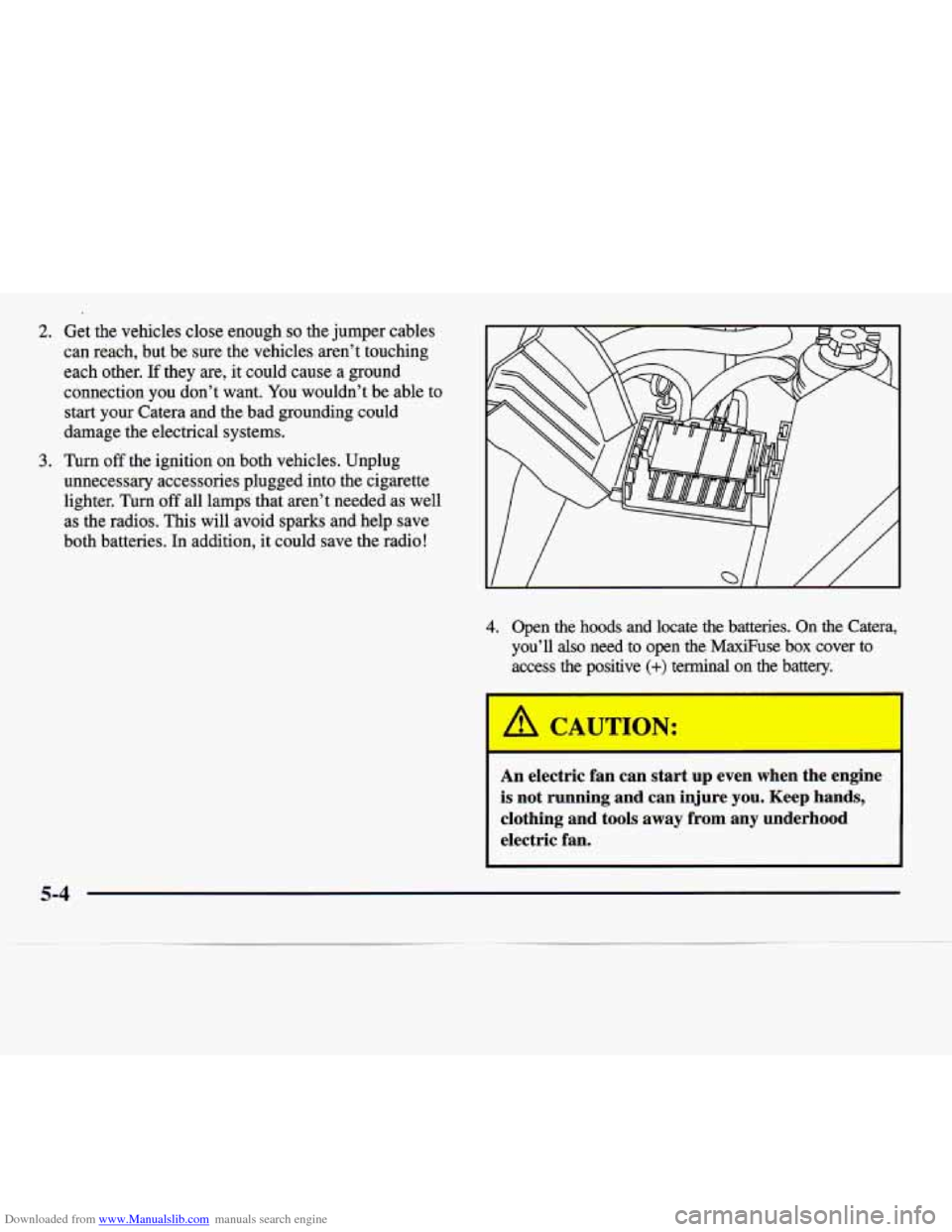
Downloaded from www.Manualslib.com manuals search engine 2.
3.
Get the vehicles close enough so the jumper cables
can reach, but be sure the vehicles aren’t touching
each other.
If they are, it could cause a ground
connection
you don’t want. You wouldn’t be able to
start your Catera and the bad grounding could
damage the electrical systems.
Turn off the ignition on both vehicles. Unplug
unnecessary accessories plugged into the cigarette
lighter. Turn
off all lamps that aren’t needed as well
as the radios. This will avoid sparks and help save
both batteries. In addition, it could save the radio!
4. Open the hoods and locate the batteries. On the Catera.
you’ll
also need to open the “use box cover to
access the positive
(+) terminal on the battery.
I ’ A CAUTION:
An electric fan can start up even when the engine
is not running and can injure you.
Keep hands,
clothing and tools away from any underhood
electric fan.
5-4
Page 212 of 338
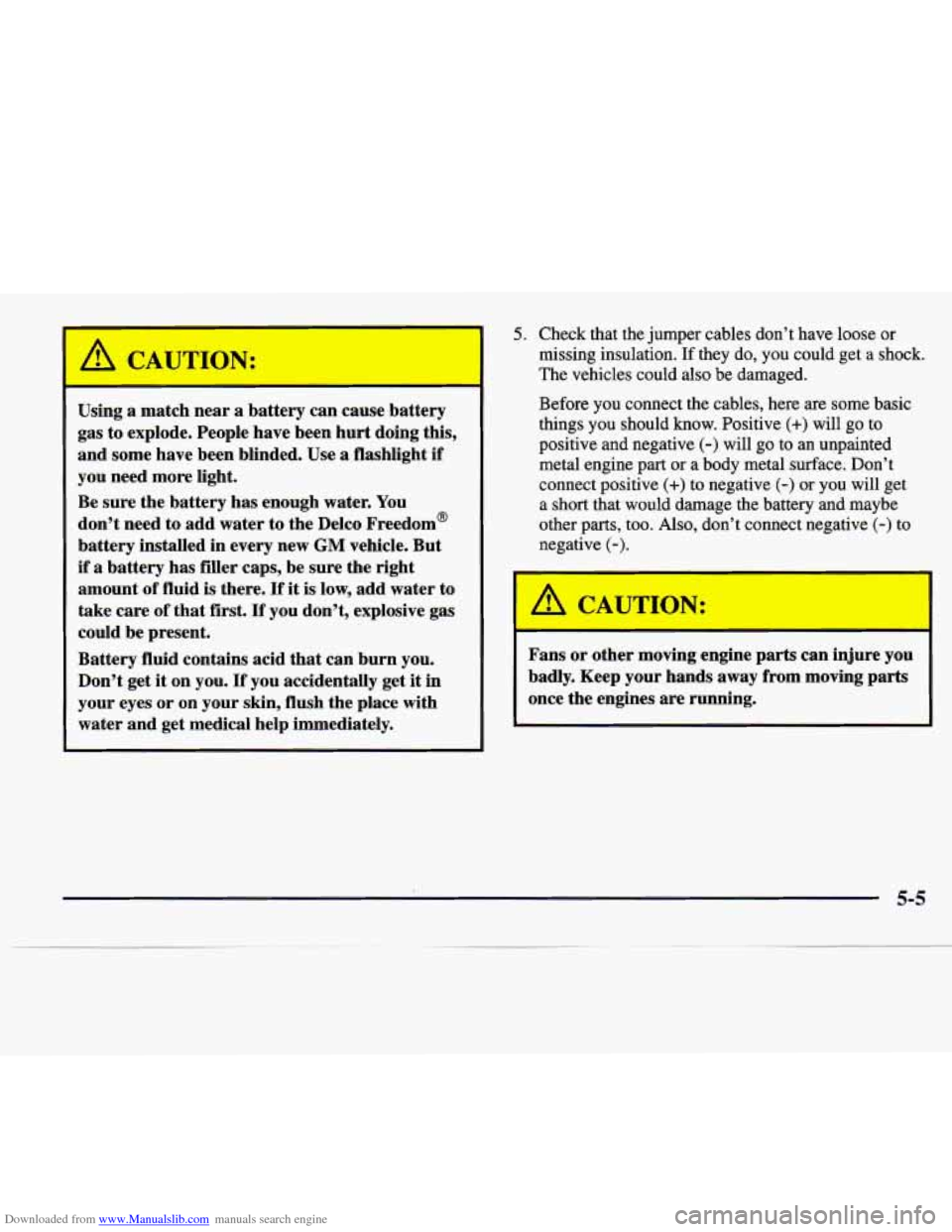
Downloaded from www.Manualslib.com manuals search engine Using a match near a battery can cause battery
gas to explode. People have been hurt doing this,
and some have been blinded. Use a flashlight if
you need more light.
Be sure the battery has enough water. You
don’t need to add water to the Delco Freedom@
battery installed in every new
GM vehicle. But
if a battery has filler caps, be sure the right
amount of fluid is there.
If it is low, add water to
take care of that first. If you don’t, explosive gas
could be present.
Battery fluid contains acid that can burn you.
Don’t get
it on you. If you accidentally get it in
your eyes or on your skin, flush the place with
water and get medical help immediately.
5. Check that the jumper cables don’t have loose or
missing insulation. If they
do, you could get a shock.
The vehicles could
also be damaged.
Before you connect the cables, here are some basic
things you should know. Positive
(+) will go to
positive and negative
(-) will go to an unpainted
metal engine part
or a body metal surface. Don’t
connect positive
(+) to negative (-) or you will get
a short that would damage the battery and maybe
other parts, too. Also, don’t connect negative
(-) to
negative
(-) .
A CAU JON:
Fans or other moving engine parts can injure you
badly. Keep your hands away from moving parts
once the engines are running.
5-5
Page 213 of 338
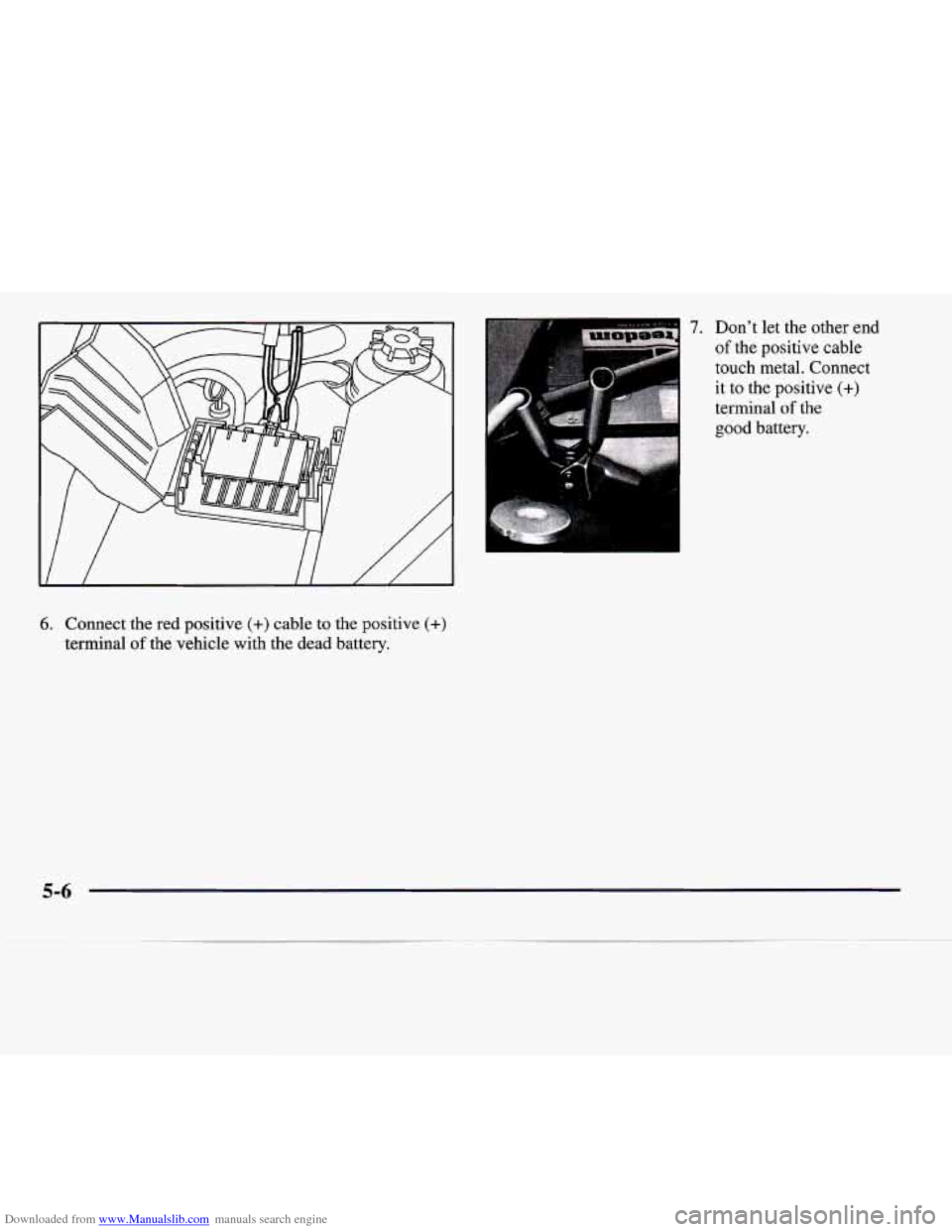
Downloaded from www.Manualslib.com manuals search engine 6. Connect the red positive (+) cable to the positive (+)
terminal of the vehicle with the dead battery.
7. Don’t let the other end
of the positive cable
touch metal. Connect
it to the positive
(+)
terminal of the
good battery.
5-6
Page 214 of 338
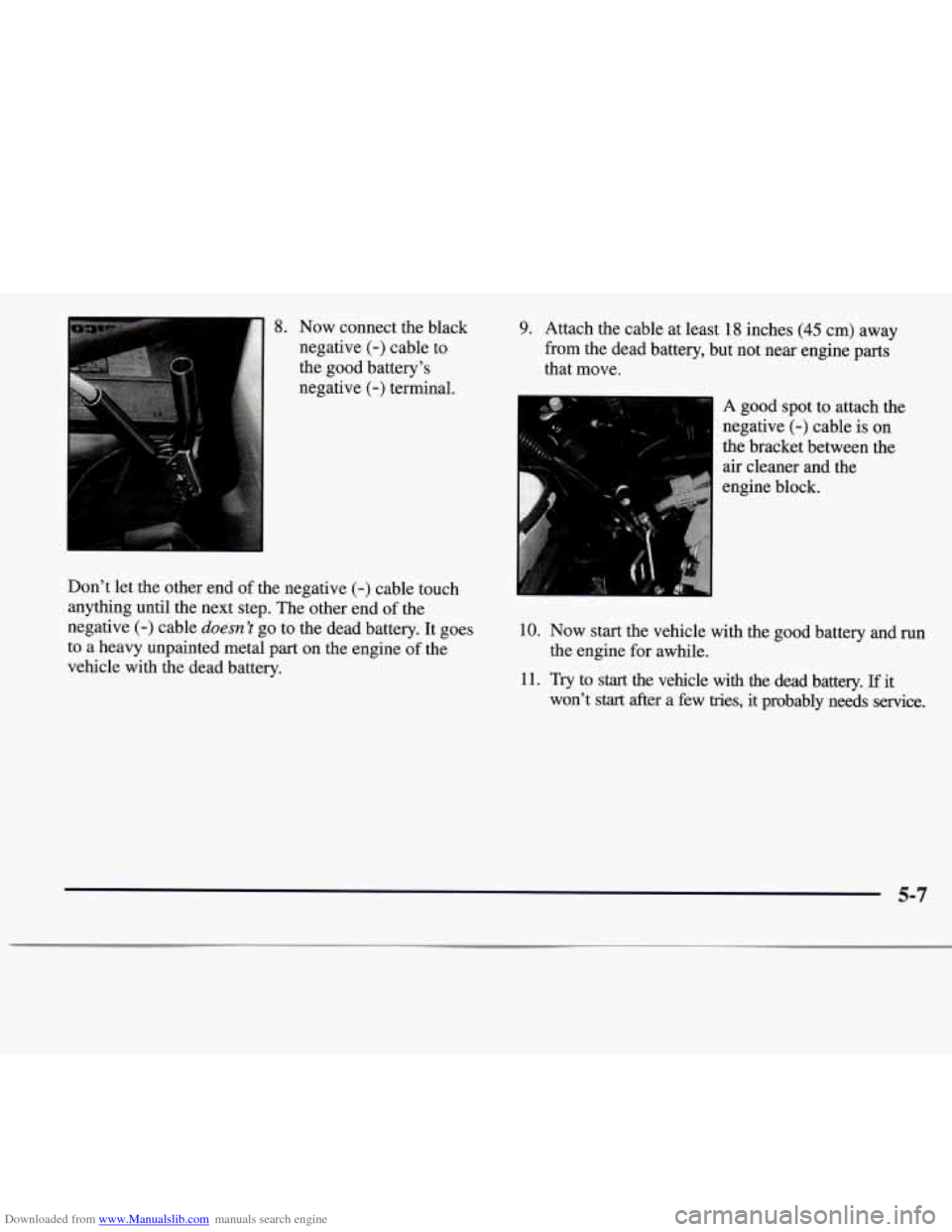
Downloaded from www.Manualslib.com manuals search engine 8. Now connect the black
negative
(-) cable to
the good battery’s
negative
(-) terminal.
Don’t let the other end of the negative
(-) cable touch
anything until the next step. The other end of the
negative
(-) cable doesn ’t go to the dead battery. It goes
to a heavy unpainted metal part on the engine of the
vehicle with the dead battery.
9. Attach the cable at least 18 inches (45 cm) away
from the dead battery, but not near engine parts
that move.
A good spot to attach the
negative
(-) cable is on
the bracket between
the
10. Now start the vehicle with the good battery and run
11. Try to start the vehicle with the dead battery. If it
the engine
for awhile.
won’t
start after a few tries, it probably needs service.
5-7
Page 215 of 338

Downloaded from www.Manualslib.com manuals search engine 12. Remove the cables in reverse order to prevent
electrical shorting. Take care that they don’t touch
each other or any other metal.
I- B +I
1
A. Heavy Metal Engine Part
B. Good Battery
C. Dead Battery
Towing Your Catera
Try to have a Catera dealer or a professional towing
service tow your Catera. See “Roadside Service”
in
the Index.
If your vehicle has been changed or modified since it
was factory-new by adding aftermarket items like fog
lamps, aero skirting or special tires and wheels, these
instructions may not be correct.
Before
you do anything, turn on the hazard
warning flashers.
When you call, tell the towing service:
That your vehicle has rear-wheel drive.
e The make, model and year of your vehicle.
e Whether you can still move the shift lever.
e If there was an accident, what was damaged.
When the towing service arrives, let the tow operator
know that this manual contains towing instructions and
illustrations. The operator may want to see them.
Page 216 of 338
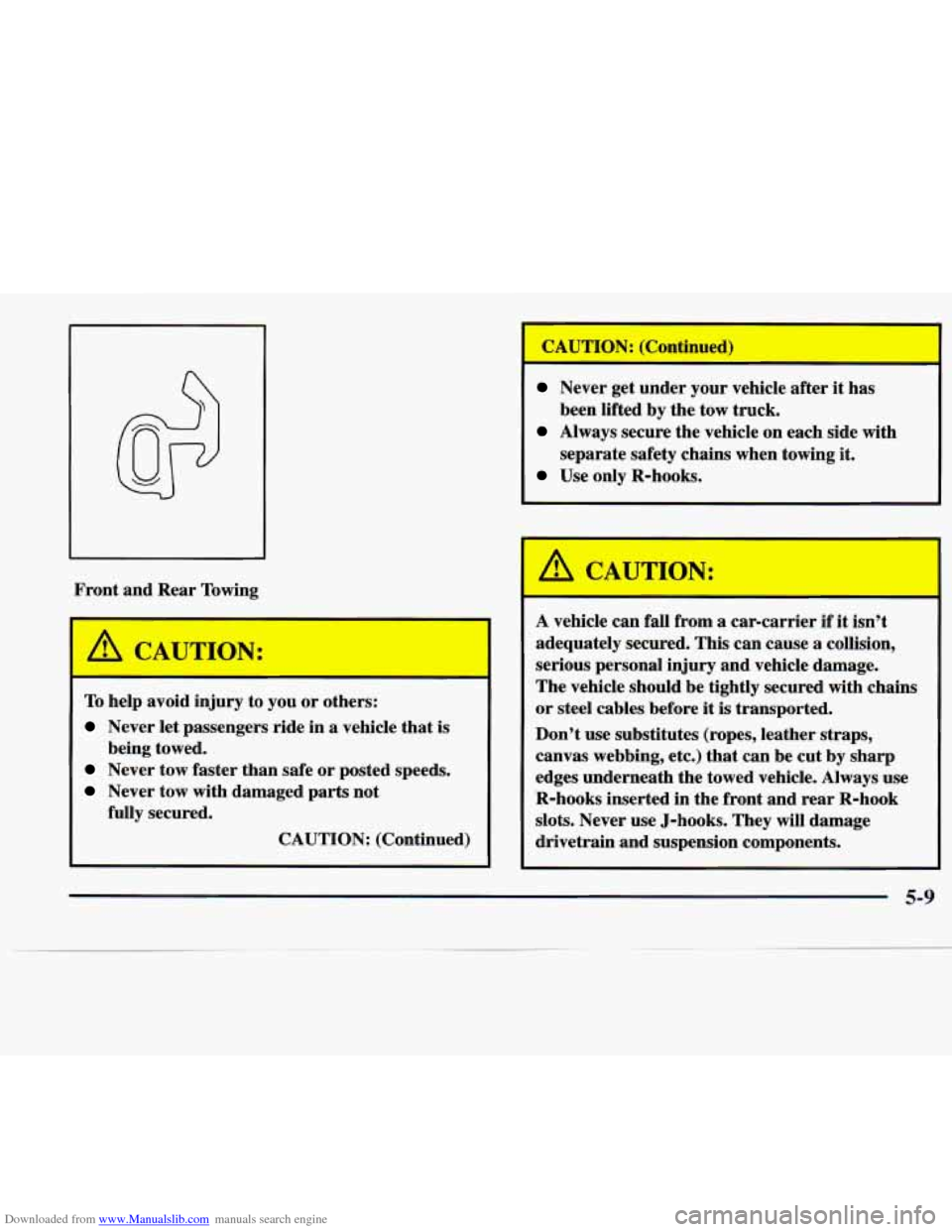
Downloaded from www.Manualslib.com manuals search engine Front and Rear Towing
-
I k!, CAUTION:
To help avoid injury to you or others:
Never let passengers ride in a vehicle that is
Never tow faster than safe or posted speeds.
Never tow with damaged parts not
being towed.
fully secured. CAUTION: (Continued)
Never get under your vehicle after it has
Always secure the vehicle on each side with
Use only R-hooks. been lifted by
the tow truck.
separate safety chains when towing it.
A CAUTION:
A vehicle can fall from a car-carrier if it isn’t
adequately secured. This can cause a collision,
serious personal injury and vehicle damage.
The vehicle should be tightly secured with chains
or steel cables before it is transported.
Don’t use substitutes (ropes, leather straps,
canvas webbing, etc.) that can be cut
by sharp
edges underneath the towed vehicle. Always use
R-hooks inserted in the front and rear R-hook
slots. Never use J-hooks. They will damage
drivetrain and suspension components.
5-9
Page 217 of 338
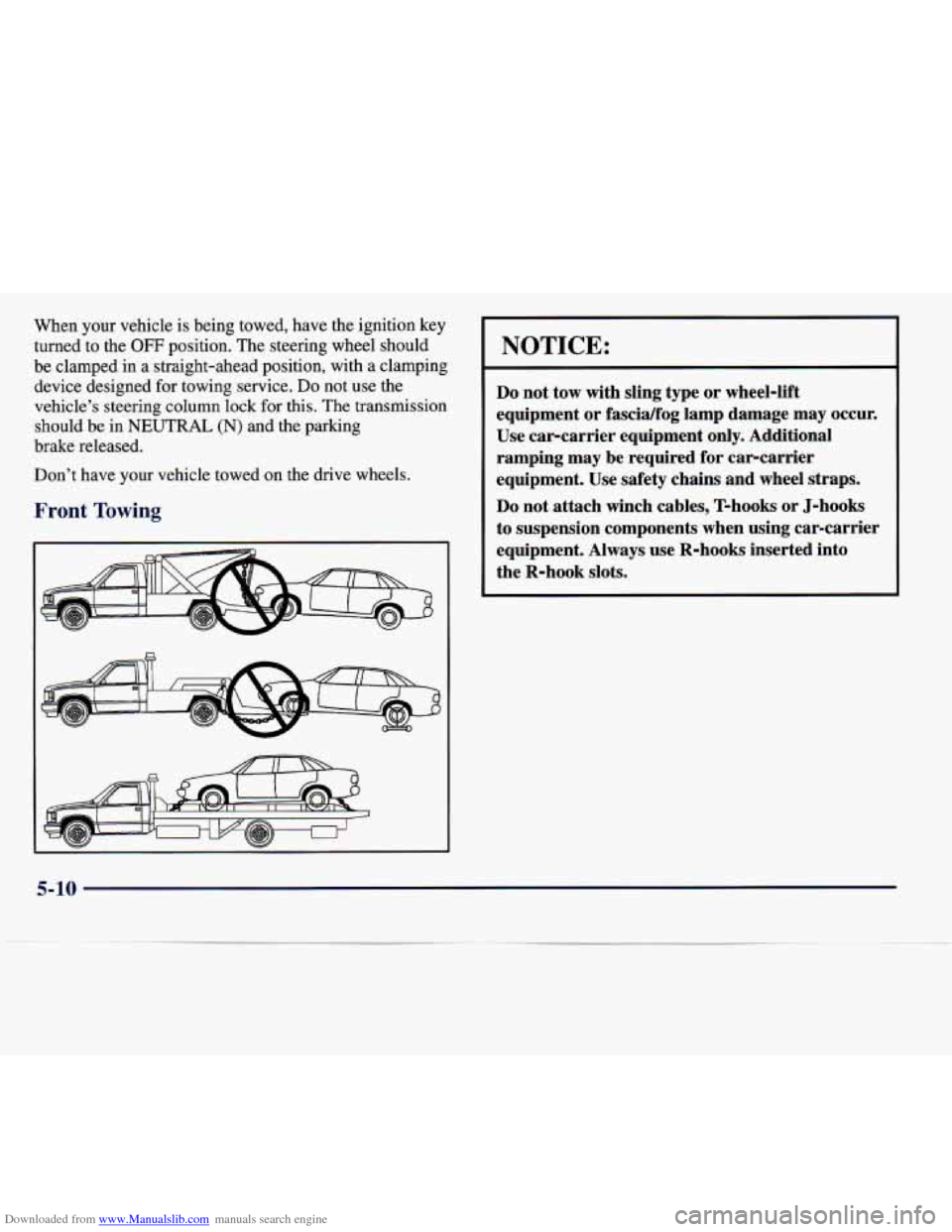
Downloaded from www.Manualslib.com manuals search engine When your vehicle is being towed, have the ignition key
turned to the
OFF position. The steering wheel should
be clamped in a straight-ahead position, with a clamping
device designed for towing service.
Do not use the
vehicle’s steering column
lock for this. The transmission
should be in
NEUTRAL (N) and the parking
brake released.
Don’t have your vehicle towed
on the drive wheels.
Front Towing
NOTICE:
Do not tow with sling type or wheel-lift
equipment or fascidfog lamp damage may occur.
Use car-carrier equipment only. Additional
ramping may be required for car-carrier
equipment. Use safety chains and wheel straps.
Do not attach winch cables, T-hooks or J-hooks
to suspension components when using car-carrier
equipment.
Always use R-hooks inserted into
the R-hook slots.
5-10
Page 218 of 338
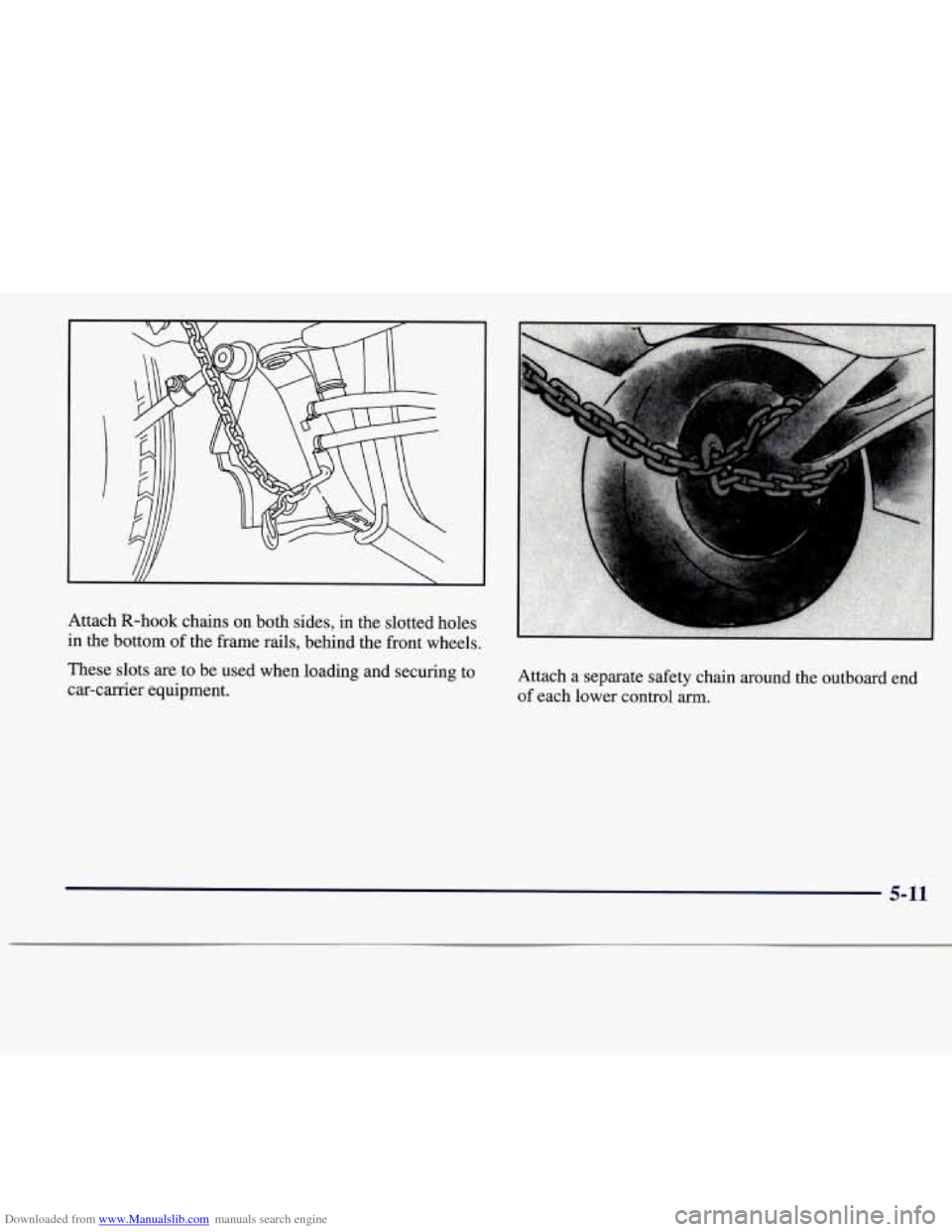
Downloaded from www.Manualslib.com manuals search engine Attach R-hook chains on both sides, in the slotted holes
in the bottom of the frame rails, behind the front wheels.
These slots are to be used when loading and securing to
car-carrier equipment.
I
Attach a separate safety chain around the outboard end
of each lower control arm.
5-11
Page 219 of 338
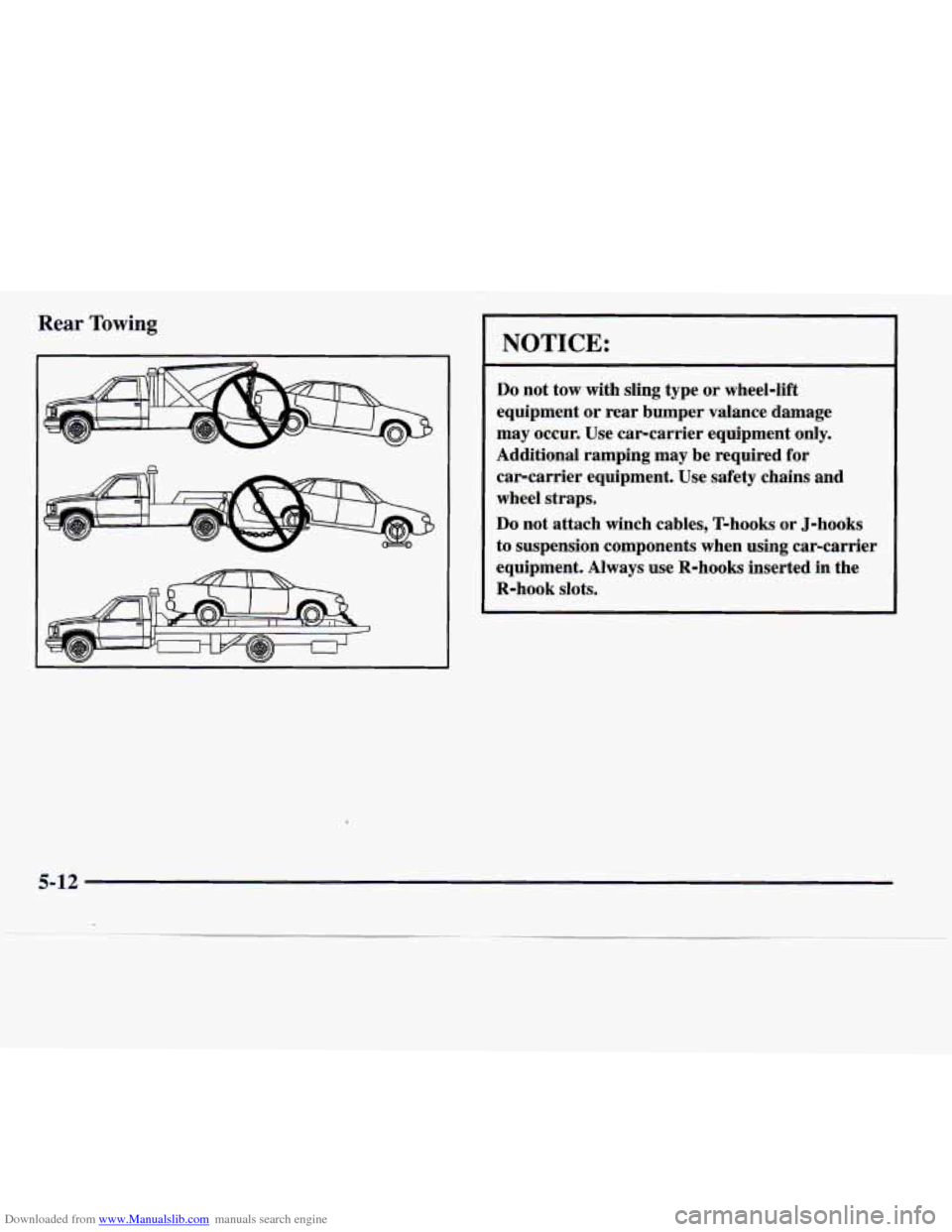
Downloaded from www.Manualslib.com manuals search engine Rear Towing
NOTICE:
Do not tow with sling type or wheel-lift
equipment or rear bumper valance damage
may occur. Use car-carrier equipment only.
Additional ramping may be required for
carcarrier equipment. Use safety chains and
wheel straps.
Do not attach winch cables, T-hooks or J-hooks
to suspension components when using car-carrier
equipment. Always use R-hooks inserted in the
R-hook
slots.
5-12
Page 220 of 338
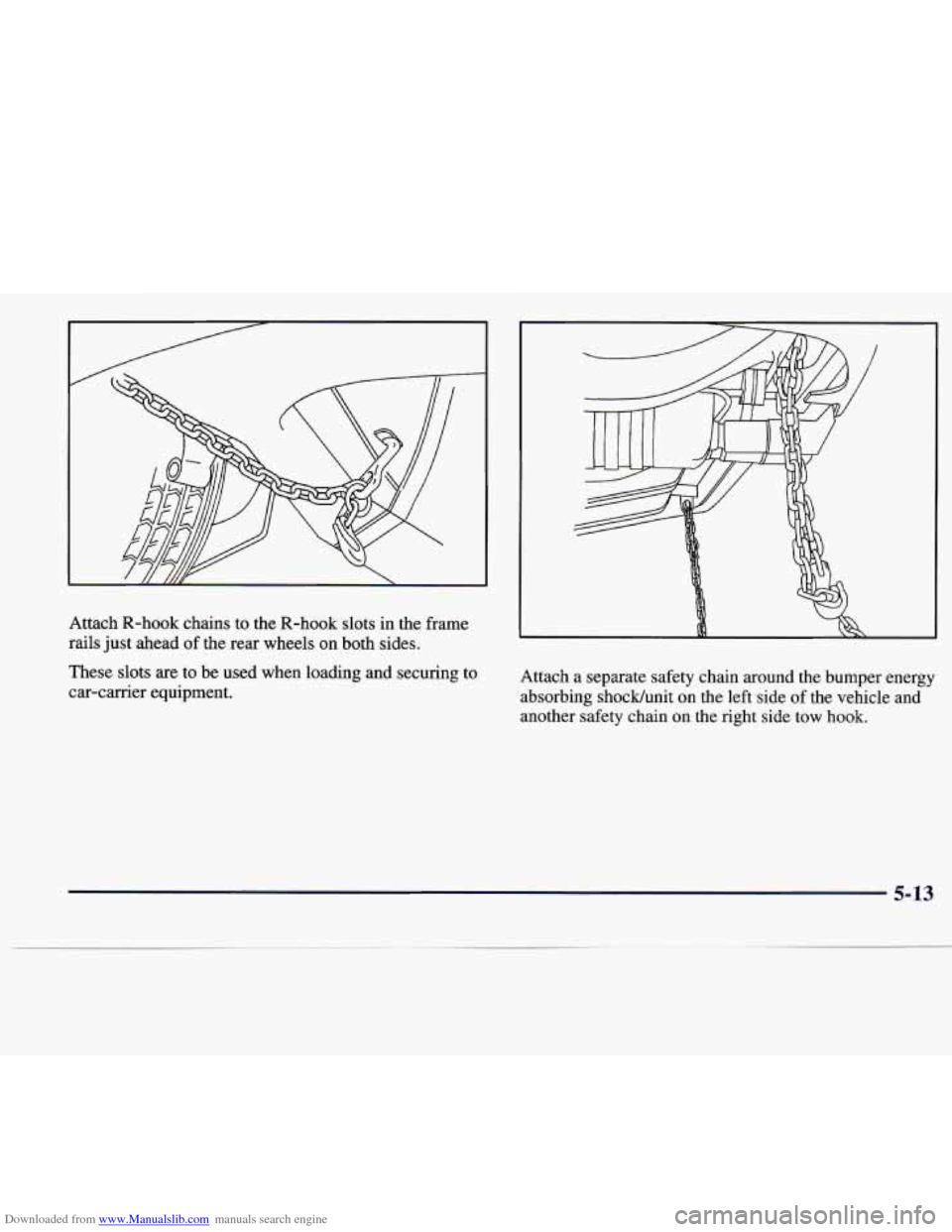
Downloaded from www.Manualslib.com manuals search engine Attach R-hook chains to the R-hook slots in the frame
rails just ahead of the rear wheels on both sides.
These slots
are to be used when loading and securing to
car-carrier equipment. Attach
a separate safety chain around the bumper energy
absorbing shockhnit on the left side
of the vehicle and
another safety chain on the right side tow hook.